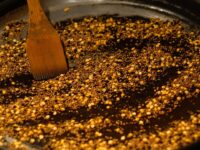Looking for an unconventional career? Meet Stuart Williams, an associate professor of engineering at the University of Louisville who conducts research about whiskey. Williams is interested in the study of colloids, a type of mixture in which solid particles are suspended in fluid. He learned from a colleague that whiskey contains colloids, and that piqued his curiosity. Not long after, Williams began studying whiskey alongside Orlin Velev, a colloid science great, looking for an answer to the question: “Can you differentiate whiskey from their evaporated drops?” Williams and Velev discovered that when a diluted drop of the spirit evaporates, it leaves behind a beautiful matrix pattern, which they dubbed a “whiskey web.”
Williams and Velev discovered that when a diluted drop of the spirit evaporates, it leaves behind a beautiful matrix pattern, which they dubbed a “whiskey web.”
Whiskey is a type of alcohol produced by distilling malted grain. Typically, whiskey is aged in charred oak wood barrels. American whiskey is aged in new charred oak wood barrels, resulting in an increased number of solid particles suspended in the alcohol. This contributes not only to the alcohol’s flavor profile and color but also to its ability to dry in a whiskey web pattern.
The aging process that whiskeys, particularly American whiskeys, undergo plays a critical role in their ability to form whiskey webs. Williams found that drops of diluted American whiskey with an alcohol by volume of 30 percent or greater resulted in a uniform, thin film when evaporated. Drops of whiskey with an alcohol by volume of around 10 percent or less resulted in coffee-ring patterns when evaporated. In the middle range, whiskey webs formed.
So how exactly are these webs produced? Williams explains that, “when you dilute whiskey with water, some of its chemicals are water insoluble, thus creating micelles that would eventually migrate to the surface [during evaporation].” This results in the formation of a chemical monolayer at the surface of the liquid. The surface area of this monolayer decreases in size during evaporation, causing a buckling phenomenon that creates web-like folds in the monolayer. These folds create the whiskey web pattern. Through his research, Williams showed that the chemical makeup of each whiskey affects the level of branching and wrinkling within its whiskey web, thus contributing to its unique pattern.
These intricate patterns can be visualized using digital imaging with a microscope or even with a smartphone. Through digital image analysis, Williams collected enough experimental data so that he was able to learn, recognize, and accurately match images of whiskey webs to the correct brand of whiskey 90 percent of the time.
Preliminary applications of Williams’s findings include using whiskey fingerprints to identify knockoffs. It is not uncommon for lower quality, younger whiskeys to be marketed as expensive, higher quality whiskeys in order to trick consumers into paying more. Through the use of whiskey web image analysis, one is able to determine which whiskeys are authentic and which are counterfeit. This process may also aid in the chemical analysis of whiskey and play a role in quality control for whiskey distillers.
Through the use of whiskey web image analysis, one is able to determine which whiskeys are authentic and which are counterfeit.
Another common pattern formed when liquid dries is called the coffee ring effect (CRE). This phenomenon occurs when a drop of colloid dries, leaving behind a stain in which the once-suspended particles dry on the perimeter of the drop. A common iteration of the CRE is seen with coffee stains, hence the name.
What occurred in Williams’s research when he evaporated whiskey of alcohol by volume between 20–25 percent defies the expected CRE behavior. Thus, these findings may have implications for the suppression of the CRE in processes involving colloids, such as painting and inkjet printing. The CRE is often seen as an imperfection in paint and ink, and thus suppressing it results in superior products. The suppression of the CRE can also be used for the detection of nucleic acid for DNA sequencing as an alternative to polymerase chain reaction.
Looking at everyday spills and stains in a new light makes life’s mundane routines all the more fascinating. It might even motivate some to prioritize washing their laundry. Perhaps there is more taking place in that blob of ketchup you spilled on your shirt then you might think! If you are interested in creating your own whiskey webs, Williams provides explicit instructions on his website: http://whiskeywebs.org.
Image Source: Spektrum


